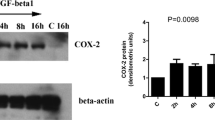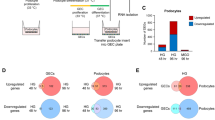Abstract
To study the role of insulin-like growth factors (IGF) in podocyte maturation, we isolated and characterized fetal visceral glomerular epithelial cells from human kidneys obtained at 8–18 weeks gestation. Cells were identified as podocyte lineage by their cobblestone morphology and immunoreactivity with synaptopodin, Wilms tumor-1 suppressor gene product (WT-1), complement receptor CR1, and cytoskeletal proteins smooth muscle actin and vimentin. Stimulation of the podocyte cell monolayers with IGF-II resulted in a slight increase in mitogenesis, an effect that was concentration and time dependent and abrogated by co-incubation with exogenous IGF binding protein 2 (IGFBP-2). Western blot analysis of conditioned media revealed that cultured podocytes expressed endogenous IGFBP-2 exclusively. IGF-II stimulation enhanced IGFBP-2 production in a dose- and time-dependent fashion and was associated with an increase in IGFBP-2 mRNA production. These data demonstrate that IGF-II-stimulated IGFBP-2 production appears to inhibit the mitogenic effect of IGF-II, and may have an autocrine effect on the maturation, differentiation, and survival of fetal podocytes.




Similar content being viewed by others
References
Mundel P, Reiser J (1997) New aspects of podocyte cell biology. Kidney Blood Press Res 20:173–176
Putaala H, Soininen R, Kilpelainen P, Wartiovaara J, Tryggvason K (2001) The murine nephrin gene is specifically expressed in kidney, brain and pancreas: inactivation of the gene leads to massive proteinuria and neonatal death. Hum Mol Genet 10:1–8
Boute N, Gribouval O, Roselli S, Benessy F, Lee H, Fuchshuber A, Dahan K, Gubler MC, Niaudet P, Antignac C (2000) NPHS2, encoding the glomerular protein podocin, is mutated in autosomal recessive steroid-resistant nephrotic syndrome. Nat Genet 24:349–354
Kaplan JM, Kim SH, North KN, Rennke H, Correia LA, Tong HQ, Mathis BJ, Rodriguez-Perez JC, Allen PG, Beggs AH, Pollak MR (2000) Mutations in ACTN4, encoding alpha-actinin-4, cause familial focal segmental glomerulosclerosis. Nat Genet 24:251–256
Shih NY, Li J, Karpitskii V, Nguyen A, Dustin ML, Kanagawa O, Miner JH, Shaw AS (1999) Congenital nephrotic syndrome in mice lacking CD2-associated protein. Science 286:312–315
Matsell DG, Delhanty PJ, Stepaniuk O, Goodyear C, Han VK (1994) Expression of insulin-like growth factor and binding protein genes during nephrogenesis. Kidney Int 46:1031–1042
Matsell DG, Gaber LW, Malik KU (1994) Cytokine stimulation of prostaglandin production inhibits the proliferation of serum-stimulated mesangial cells. Kidney Int 45:159–165
Mundel P, Reiser J, Kriz W (1997) Induction of differentiation in cultured rat and human podocytes. J Am Soc Nephrol 8:697–705
Matsell DG, Gaber LW, Sehic E, Malik KU (1993) Interleukin 1 and interleukin 6 inhibition of mesangial cell proliferation: role of PGE2. J Lipid Mediat 6:343–352
Matsell DG, Bennett T (1998) Evaluation of metanephric maturation in a human fetal kidney explant model. In Vitro Cell Dev Biol Anim 34:138–148
Lipschutz JH (1998) Molecular development of the kidney: a review of the results of gene disruption studies. Am J Kidney Dis 31:383–397
Bates CM (2000) Kidney development: regulatory molecules crucial to both mice and men. Mol Genet Metab 71:391–396
Sariola H, Saarma M (1999) GDNF and its receptors in the regulation of the ureteric branching. Int J Dev Biol 43:413–418
Schuchardt A, D'Agati V, Larsson-Blomberg L, Costantini F, Pachnis V (1994) Defects in the kidney and enteric nervous system of mice lacking the tyrosine kinase receptor Ret. Nature 367:380–383
Pichel JG, Shen L, Sheng HZ, Granholm AC, Drago J, Grinberg A, Lee EJ, Huang SP, Saarma M, Hoffer BJ, Sariola H, Westphal H (1996) Defects in enteric innervation and kidney development in mice lacking GDNF. Nature 382:73–76
Jena N, Martin-Seisdedos C, McCue P, Croce CM (1997) BMP7 null mutation in mice: developmental defects in skeleton, kidney, and eye. Exp Cell Res 230:28–37
Rogers SA, Ryan G, Hammerman MR (1992) Metanephric transforming growth factor-alpha is required for renal organogenesis in vitro. Am J Physiol 262:F533–F539
Threadgill DW, Dlugosz AA, Hansen LA, Tennenbaum T, Lichti U, Yee D, LaMantia C, Mourton T, Herrup K, Harris RC (1995) Targeted disruption of mouse EGF receptor: effect of genetic background on mutant phenotype. Science 269:230–234
Rogers SA, Ryan G, Hammerman MR (1991) Insulin-like growth factors I and II are produced in the metanephros and are required for growth and development in vitro. J Cell Biol 113:1447–1453
Baker J, Liu JP, Robertson EJ, Efstratiadis A (1993) Role of insulin-like growth factors in embryonic and postnatal growth. Cell 75:73–82
DeChiara TM, Efstratiadis A, Robertson EJ (1990) A growth-deficiency phenotype in heterozygous mice carrying an insulin-like growth factor II gene disrupted by targeting. Nature 345:78–80
Liu JP, Baker J, Perkins AS, Robertson EJ, Efstratiadis A (1993) Mice carrying null mutations of the genes encoding insulin-like growth factor I (Igf-1) and type 1 IGF receptor (Igf1r). Cell 75:59–72
Hise MK, Li L, Mantzouris N, Rohan RM (1995) Differential mRNA expression of insulin-like growth factor system during renal injury and hypertrophy. Am J Physiol 269:F817–F824
Lee DY, Park SK, Yorgin PD, Cohen P, Oh Y, Rosenfeld RG (1994) Alteration in insulin-like growth factor-binding proteins (IGFBPs) and IGFBP-3 protease activity in serum and urine from acute and chronic renal failure. J Clin Endocrinol Metab 79:1376–1382
Powell DR, Liu F, Baker BK, Hinzt RL, Kale A, Suwanichkul A, Durham SK (2000) Effect of chronic renal failure and growth hormone therapy on the insulin-like growth factors and their binding proteins. Pediatr Nephrol 14:579–583
Tsao T, Wang J, Fervenza FC, Vu TH, Jin IH, Hoffman AR, Rabkin R (1995) Renal growth hormone-insulin-like growth factor-I system in acute renal failure. Kidney Int 47:1658–1668
Sheikh MS, Shao ZM, Hussain A, Clemmons DR, Chen JC, Roberts CT Jr, LeRoith D, Fontana JA (1993) Regulation of insulin-like growth factor-binding-protein-1, 2, 3, 4, 5, and 6: synthesis, secretion, and gene expression in estrogen receptor-negative human breast carcinoma cells. J Cell Physiol 155:556–567
Bradshaw SL, Han VK (1993) Hormonal regulation of astroglial insulin-like growth factor (IGF)-binding protein gene expression by IGFs and insulin. Endocrinology 133:1767–1777
Boisclair YR, Yang YW, Stewart JM, Rechler MM (1994) Insulin-like growth factor-I and insulin stimulate the synthesis of IGF-binding protein-2 in a human embryonic kidney cell line. Growth Regul 4:136–146
Langford K, Nicolaides K, Miell JP (1998) Maternal and fetal insulin-like growth factors and their binding proteins in the second and third trimesters of human pregnancy. Hum Reprod 13:1389–1393
Jones JI, Clemmons DR (1995) Insulin-like growth factors and their binding proteins: biological actions. Endocr Rev 16:3–34
Wood TL, Rogler LE, Czick ME, Schuller AG, Pintar JE (2000) Selective alterations in organ sizes in mice with a targeted disruption of the insulin-like growth factor binding protein-2 gene. Mol Endocrinol 14:1472–1482
Ruoslahti E, Pierschbacher MD (1987) New perspectives in cell adhesion: RGD and integrins. Science 238:491–497
Allan GJ, Flint DJ, Darling SM, Geh J, Patel K (2000) Altered expression of insulin-like growth factor-1 and insulin like growth factor binding proteins-2 and 5 in the mouse mutant Hypodactyly (Hd) correlates with sites of apoptotic activity. Anat Embryol (Berl) 202:1–11
Baker NL, Russo CV, Bernard O, D'Ercole AJ, Werther GA (1999) Interactions between bcl-2 and the IGF system control apoptosis in the developing mouse brain. Brain Res Dev Brain Res 118:109–118
Rajah R, Valentinis B, Cohen P (1997) Insulin-like growth factor (IGF)-binding protein-3 induces apoptosis and mediates the effects of transforming growth factor-beta1 on programmed cell death through a p53- and IGF-independent mechanism. J Biol Chem 272:12181–12188
Gill ZP, Perks CM, Newcomb PV, Holly JM (1997) Insulin-like growth factor-binding protein (IGFBP-3) predisposes breast cancer cells to programmed cell death in a non-IGF-dependent manner. J Biol Chem 272:25602–25607
Acknowledgements
This work was supported by grants from the Kidney Foundation of Canada and the Child Health Research Institute (D.G.M.) and Natural Sciences and Engineering Research Council (D.J.B.).
Author information
Authors and Affiliations
Corresponding author
Rights and permissions
About this article
Cite this article
Bridgewater, D.J., Matsell, D.G. Insulin-like growth factor binding protein-2 modulates podocyte mitogenesis. Pediatr Nephrol 18, 1109–1115 (2003). https://doi.org/10.1007/s00467-003-1242-x
Received:
Revised:
Accepted:
Published:
Issue Date:
DOI: https://doi.org/10.1007/s00467-003-1242-x




